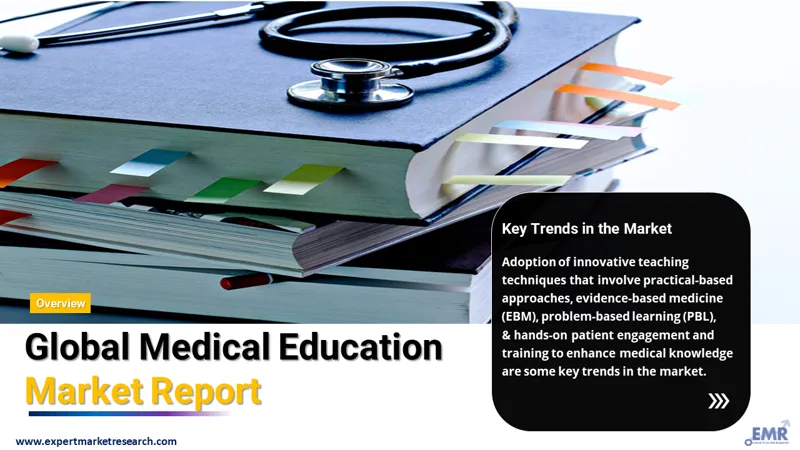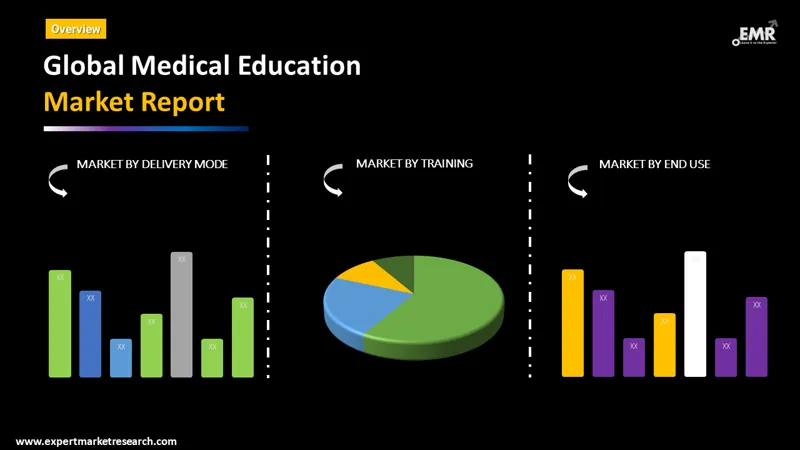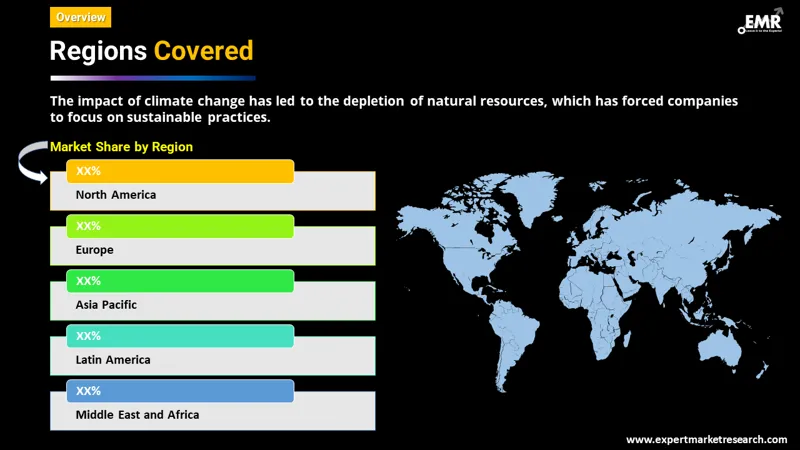Reports
Sale

Global Medical Education Market Size, Share, Research: By Delivery Mode: Classroom-Based Course, Distance, Online, Others; By Training: Cardiothoracic, Neurology, Orthopaedic, Oral and Maxillofacial, Paediatric, Radiology, Laboratory, Others; By End Use: School of Medicine, Others; Regional Analysis; Competitive Landscape; 2024-2032
Global Medical Education Market Outlook
The global medical education market size was valued at USD 43.89 billion in 2023. The market is further projected to grow at a CAGR of 5.5% between 2024 and 2032.
Key Takeaways
- In India, the number of medical colleges rose from 387 in 2014 to 704 in 2023, valued at an 82% increase.
- In 2022, there were an estimated 2,370 cardiologists employed in the United States.
- New York had the highest number of cardiologists in 2022.
Medical education is the process of training and developing health professionals who can provide quality care and services to patients and communities. Medical education encompasses various levels of education, from undergraduate to postgraduate, and covers different fields of medicine, such as general practice, surgery, paediatrics, and psychiatry.
Some of the factors that influence the demand of medical education are population growth, growing ageing demographics, high disease burden, health system and education reformation, and technological innovations in the field of medicine. The medical education market growth is driven by the increasing demand for health professionals, especially in developing regions, the rising prevalence of chronic and infectious diseases, the growing adoption of online and hybrid learning modes, and the expansion of medical schools and universities.

Read more about this report - REQUEST FREE SAMPLE COPY IN PDF
Key Trends and Developments
Online and hybrid learning modes, integration of artificial intelligence (AI) and big data, and adoption of simulation-based training are boosting the medical education market growth
| Date | Event | Description |
| January 2024 | Harvard Medical School's Junior HealthTech Fellowship Program | Teaches participants how to solve problems in the healthcare industry by using biodesign framework developed by Stanford. This initiative aims to prepare students for future careers in the intersection of health care and technology. |
| July 2021 | Philips and Cognizant Collaboration | Presented patients, researchers, and professionals with digital health solutions. The purpose of this partnership is to better connect patients and providers while managing the expanding volume of health data. |
| April 2020 | University of Oxford's Medical Sciences Division OxSTaR Facility | Offers a teaching and research facility, called Oxford Simulation. It trains neurology staff by running simulated scenarios with highly realistic functioning models of patients known as manikins. |
| Trends | Impact |
| Increase in online and hybrid learning modes | Reduced cost and increased accessibility of medical education for learners across the globe, especially in remote and underserved areas. Online and hybrid learning modes also offer more flexibility and convenience for busy and working learners, propelling the medical education market development. |
| Adoption of simulation-based training and assessment | Enhanced skill development and evaluation of medical students in a safe and realistic environment, without risking patient safety or compromising quality of care. Simulation-based training and assessment also enable more frequent and effective feedback and remediation. |
| Integration of artificial intelligence (AI) and big data analytics | Improved personalisation, feedback, and decision making in medical education and practice, by leveraging the power of data and algorithms to tailor learning experiences, provide adaptive and timely feedback, and support clinical reasoning and diagnosis. |
| Focus on interprofessional and interdisciplinary education | Fosters teamwork, communication, and collaboration among different health professionals and disciplines, to improve patient outcomes and quality of care. Interprofessional and interdisciplinary education also help to break down hierarchies in the health system and promote a culture of mutual respect and learning. |
Global Medical Education Market Trends
The developing region's rapidly growing population is one of the factors propelling the medical education market growth. For instance, Asia Pacific region has an increased demand for healthcare services, which has resulted in a larger workforce and increased need for healthcare education solutions. Additionally, the rise in enrolments for medical education, the expansion of modern educational frameworks, and the transition to competency-based medical education are contributing to market growth in regions like Europe and North America.
Furthermore, the implementation of narrative medicine and the digitalisation in medical training in countries like Japan, Singapore, and India are emerging trends in medical education. This dynamic landscape is fostering continuous advancements and elevating educational standards, further contributing to medical education market expansion.
Furthermore, digitalisation has played a significant role in unlocking countless possibilities for the medical education market development. The universities are adopting integrated, rather than traditional, discipline-based curriculums, further implementing innovative teaching methods such as practical based approaches, evidence-based medicine (EBM), problem-based learning (PBL), and hands-on interaction and training with patients, to build their medical knowledge.
In the forecast period, medical education through internet platforms is likely to improve as it offers unparalleled access to fresh study methods like the customisation of pace, and interactive learning through videos and audios, which are cost-effective as well. In addition, continuing medical education (CME) offers support for continuous learning, helping medical professionals to address the gaps in their professional practice, which is expected to aid the medical education market growth in future.

Read more about this report - REQUEST FREE SAMPLE COPY IN PDF
Market Segmentation
Global Medical Education Market Report and Forecast 2024-2032 offers a detailed analysis of the market based on the following segments:
| Market Breakup | Categories |
| Delivery Mode | Classroom-Based Course, Distance, Online, Others |
| Training | Cardiothoracic, Neurology, Orthopaedic, Oral and Maxillofacial, Paediatric, Radiology, Laboratory, Others |
| End Use | School of Medicine, Government/Military Organisations, Hospital, Insurance & Company, Non-Profit Organisations, Publishing or Education Company, Others |
| Region | North America, Europe, Asia Pacific, Latin America, Middle East and Africa |
Cardiothoracic training segment is expected to hold significant market share due to the high demand for cardiac surgeons and cardiologists
Among the training segments, the cardiothoracic segment leads the medical education market share due to the high demand for cardiac surgeons and cardiologists and the need for continuous skill development and training.
The neurology segment is expected to witness the fastest growth over the forecast period due to the increasing incidence of neurological disorders, such as Alzheimer's, Parkinson's, stroke, and epilepsy, the rising awareness about brain health, and the availability of advanced simulation-based training tools for neurologists.
The orthopaedic segment is also expected to witness significant growth in the medical education market, as orthopaedic surgery is one of the most sought-after specialties among medical students and residents, and the demand for orthopaedic surgeons is expected to increase with the ageing population and the rising cases of musculoskeletal injuries and disorders.
The oral and maxillofacial segment is another important segment which can increase the overall medical education market size, as it involves the diagnosis and treatment of various diseases, injuries, and defects affecting the face, mouth, teeth, and jaws. The segment requires specialised training and certification, and the adoption of digital technologies, such as virtual reality and augmented reality, which has enhanced the learning experience for oral and maxillofacial surgeons.
The paediatric segment is also a vital segment in the healthcare education market, as it covers the health and well-being of children from birth to adolescence. Paediatricians require extensive training and education to deal with the diverse and complex medical needs of children. The segment also benefits from the availability of various online courses, webinars, podcasts, and e-learning platforms that provide updated and evidence-based information and guidance for paediatric practice.
Online learning have captured a significant market after the emergence of pandemic
According to the medical education market analysis, online courses are predicted to grow at a highest CAGR. It is a modern mode of medical education, where students access lectures, materials, and assessments through web-based platforms, such as e-learning, virtual classrooms, webinars, podcasts, and mobile applications. This mode offers many advantages, such as accessibility, interactivity, personalisation, and scalability, along with the integration of multimedia, simulation, and gamification. However, online courses also face challenges, such as technical issues, security risks, plagiarism, and attrition.
On the other hand, distance courses are another mode of medical education, where students receive materials and instructions through mail, phone, fax, or email, and complete assignments and assessments remotely. This mode is contributing positively to medical education market outlook as it offers flexibility, convenience, and affordability for students who cannot attend regular classes due to personal or professional reasons. However, distance courses also have drawbacks, such as lack of interaction, feedback, and supervision, as well as potential issues with quality, accreditation, and recognition.
Meanwhile, classroom-based courses are the traditional mode of medical education, where students attend lectures, seminars, labs, and clinical sessions in person. This mode offers direct interaction with instructors and peers, hands-on experience, and access to facilities and equipment to medical students. Even though classroom-based courses are limited by geographical constraints, they can be highly beneficial, especially for practical training. Specific programs like the Facial Anatomy Cadaver Lab provide hands-on practice on fresh cadaver tissue, allowing participants to enhance their anatomical knowledge and surgical skills. These factors collectively have escalated the medical education market value.

Read more about this report - REQUEST FREE SAMPLE COPY IN PDF
Competitive Landscape
The market landscape is continuously evolving with market players focused on providing digital medical education and comprehensive research and training facilities.
| Company Name | Year Founded | Headquarters | Products/Services |
| Harvard Medical School | 1782 | Massachusetts, United States | Medical education, research, and clinical care |
| Koninklijke Philips N.V. | 1891 | Amsterdam, Netherlands | Health technology, consumer electronics, lighting, and personal care |
| Siemens Healthcare GmBH | 1847 | Erlangen, Germany | Medical imaging, laboratory diagnostics, therapy systems, and digital health solutions |
| Zimmer Biomet Holdings, Inc. | 1927 | Indiana, United States | Musculoskeletal products, such as joint replacements, dental implants, trauma devices, and spine products |
Other medical education companies in the market report include University of Oxford, University of Cambridge, Stanford University, Gundersen Health System, and Olympus Corporation, among others.
Global Medical Education Market Analysis by Region
North America is one of the prominent regions due to the presence of well-established medical schools and hospitals
According to medical education market report, North America accounts for the largest share of the market due to the high demand for advanced medical education, the presence of well-established medical schools and hospitals, and the availability of funding and scholarships for medical students.
The Asia Pacific region is expected to witness the fastest growth rate during the forecast period, due to the increasing population, the rising awareness about healthcare, the growing number of medical colleges and universities, and the improving quality of medical education in the region.
Europe also holds a significant share of the medical education market, driven by the high standards of medical education, the diversity of courses and specialities, and the mobility of students and faculty within the region.
Key Highlights of the Report
| REPORT FEATURES | DETAILS |
| Base Year | 2023 |
| Historical Period | 2018-2023 |
| Forecast Period | 2024-2032 |
| Scope of the Report |
Historical and Forecast Trends, Industry Drivers and Constraints, Historical and Forecast Market Analysis by Segment:
|
| Breakup by Delivery Mode |
|
| Breakup by Training |
|
| Breakup by End Use |
|
| Breakup by Region |
|
| Market Dynamics |
|
| Competitive Landscape |
|
| Companies Covered |
|
| Report Price and Purchase Option | Explore our purchase options that are best suited to your resources and industry needs. |
| Delivery Format | Delivered as an attached PDF and Excel through email, with an option of receiving an editable PPT, according to the purchase option. |
*At Expert Market Research, we strive to always give you current and accurate information. The numbers depicted in the description are indicative and may differ from the actual numbers in the final EMR report.
1 Preface
2 Report Coverage – Key Segmentation and Scope
3 Report Description
3.1 Market Definition and Outlook
3.2 Properties and Applications
3.3 Market Analysis
3.4 Key Players
4 Key Assumptions
5 Executive Summary
5.1 Overview
5.2 Key Drivers
5.3 Key Developments
5.4 Competitive Structure
5.5 Key Industrial Trends
6 Market Snapshot
6.1 Global
6.2 Regional
7 Opportunities and Challenges in the Market
8 Global Medical Education Market Analysis
8.1 Key Industry Highlights
8.2 Global Medical Education Historical Market (2018-2023)
8.3 Global Medical Education Market Forecast (2024-2032)
8.4 Global Medical Education Market by Delivery Mode
8.4.1 Classroom-Based Course
8.4.1.1 Historical Trend (2018-2023)
8.4.1.2 Forecast Trend (2024-2032)
8.4.2 Distance
8.4.2.1 Historical Trend (2018-2023)
8.4.2.2 Forecast Trend (2024-2032)
8.4.3 Online
8.4.3.1 Historical Trend (2018-2023)
8.4.3.2 Forecast Trend (2024-2032)
8.4.4 Others
8.5 Global Medical Education Market by Training
8.5.1 Cardiothoracic
8.5.1.1 Historical Trend (2018-2023)
8.5.1.2 Forecast Trend (2024-2032)
8.5.2 Neurology
8.5.2.1 Historical Trend (2018-2023)
8.5.2.2 Forecast Trend (2024-2032)
8.5.3 Orthopaedic
8.5.3.1 Historical Trend (2018-2023)
8.5.3.2 Forecast Trend (2024-2032)
8.5.4 Oral and Maxillofacial
8.5.4.1 Historical Trend (2018-2023)
8.5.4.2 Forecast Trend (2024-2032)
8.5.5 Paediatric
8.5.5.1 Historical Trend (2018-2023)
8.5.5.2 Forecast Trend (2024-2032)
8.5.6 Radiology
8.5.6.2 Historical Trend (2018-2023)
8.5.6.2 Forecast Trend (2024-2032)
8.5.7 Laboratory
8.5.7.1 Historical Trend (2018-2023)
8.5.7.2 Forecast Trend (2024-2032)
8.5.8 Others
8.6 Global Medical Education Market by End Use
8.6.1 School of Medicine
8.6.1.1 Historical Trend (2018-2023)
8.6.1.2 Forecast Trend (2024-2032)
8.6.2 Government/Military Organisations
8.6.2.1 Historical Trend (2018-2023)
8.6.2.2 Forecast Trend (2024-2032)
8.6.3 Hospital
8.6.3.1 Historical Trend (2018-2023)
8.6.3.2 Forecast Trend (2024-2032)
8.6.4 Insurance & Company
8.6.4.1 Historical Trend (2018-2023)
8.6.4.2 Forecast Trend (2024-2032)
8.6.5 Non-Profit Organisation
8.6.5.1 Historical Trend (2018-2023)
8.6.5.2 Forecast Trend (2024-2032)
8.6.6 Publishing or Education Company
8.6.6.1 Historical Trend (2018-2023)
8.6.6.2 Forecast Trend (2024-2032)
8.6.7 Others
8.7 Global Medical Education Market by Region
8.7.1 North America
8.7.1.1 Historical Trend (2018-2023)
8.7.1.2 Forecast Trend (2024-2032)
8.7.2 Europe
8.7.2.1 Historical Trend (2018-2023)
8.7.2.2 Forecast Trend (2024-2032)
8.7.3 Asia Pacific
8.7.3.1 Historical Trend (2018-2023)
8.7.3.2 Forecast Trend (2024-2032)
8.7.4 Latin America
8.7.4.1 Historical Trend (2018-2023)
8.7.4.2 Forecast Trend (2024-2032)
8.7.5 Middle East and Africa
8.7.5.1 Historical Trend (2018-2023)
8.7.5.2 Forecast Trend (2024-2032)
9 North America Medical Education Market Analysis
9.1 United States of America
9.1.1 Historical Trend (2018-2023)
9.1.2 Forecast Trend (2024-2032)
9.2 Canada
9.2.1 Historical Trend (2018-2023)
9.2.2 Forecast Trend (2024-2032)
10 Europe Medical Education Market Analysis
10.1 United Kingdom
10.1.1 Historical Trend (2018-2023)
10.1.2 Forecast Trend (2024-2032)
10.2 Germany
10.2.1 Historical Trend (2018-2023)
10.2.2 Forecast Trend (2024-2032)
10.3 France
10.3.1 Historical Trend (2018-2023)
10.3.2 Forecast Trend (2024-2032)
10.4 Italy
10.4.1 Historical Trend (2018-2023)
10.4.2 Forecast Trend (2024-2032)
10.5 Others
11 Asia Pacific Medical Education Market Analysis
11.1 China
11.1.1 Historical Trend (2018-2023)
11.1.2 Forecast Trend (2024-2032)
11.2 Japan
11.2.1 Historical Trend (2018-2023)
11.2.2 Forecast Trend (2024-2032)
11.3 India
11.3.1 Historical Trend (2018-2023)
11.3.2 Forecast Trend (2024-2032)
11.4 ASEAN
11.4.1 Historical Trend (2018-2023)
11.4.2 Forecast Trend (2024-2032)
11.5 Australia
11.5.2 Historical Trend (2018-2023)
11.5.2 Forecast Trend (2024-2032)
11.6 Others
12 Latin America Medical Education Market Analysis
12.1 Brazil
12.1.1 Historical Trend (2018-2023)
12.1.2 Forecast Trend (2024-2032)
12.2 Argentina
12.2.1 Historical Trend (2018-2023)
12.2.2 Forecast Trend (2024-2032)
12.3 Mexico
12.3.1 Historical Trend (2018-2023)
12.3.2 Forecast Trend (2024-2032)
12.4 Others
13 Middle East and Africa Medical Education Market Analysis
13.1 Saudi Arabia
13.1.1 Historical Trend (2018-2023)
13.1.2 Forecast Trend (2024-2032)
13.2 United Arab Emirates
13.2.1 Historical Trend (2018-2023)
13.2.2 Forecast Trend (2024-2032)
13.3 Nigeria
13.3.1 Historical Trend (2018-2023)
13.3.2 Forecast Trend (2024-2032)
13.4 South Africa
13.4.1 Historical Trend (2018-2023)
13.4.2 Forecast Trend (2024-2032)
13.5 Others
14 Market Dynamics
14.1 SWOT Analysis
14.1.1 Strengths
14.1.2 Weaknesses
14.1.3 Opportunities
14.1.4 Threats
14.2 Porter’s Five Forces Analysis
14.2.1 Supplier’s Power
14.2.2 Buyer’s Power
14.2.3 Threat of New Entrants
14.2.4 Degree of Rivalry
14.2.5 Threat of Substitutes
14.3 Key Indicators for Demand
14.4 Key Indicators for Price
15 Value Chain Analysis
16 Competitive Landscape
16.1 Market Structure
16.2 Company Profiles
16.2.1 Harvard Medical School
16.2.1.1 Company Overview
16.2.1.2 Product Portfolio
16.2.1.3 Demographic Reach and Achievements
16.2.1.4 Certifications
16.2.2 University of Oxford
16.2.2.1 Company Overview
16.2.2.2 Product Portfolio
16.2.2.3 Demographic Reach and Achievements
16.2.2.4 Certifications
16.2.3 University of Cambridge
16.2.3.1 Company Overview
16.2.3.2 Product Portfolio
16.2.3.3 Demographic Reach and Achievements
16.2.3.4 Certifications
16.2.4 Stanford Medicine
16.2.4.1 Company Overview
16.2.4.2 Product Portfolio
16.2.4.3 Demographic Reach and Achievements
16.2.4.4 Certifications
16.2.5 Gundersen Health System
16.2.5.1 Company Overview
16.2.5.2 Product Portfolio
16.2.5.3 Demographic Reach and Achievements
16.2.5.4 Certifications
16.2.6 Koninklijke Philips N.V.
16.2.6.1 Company Overview
16.2.6.2 Product Portfolio
16.2.6.3 Demographic Reach and Achievements
16.2.6.4 Certifications
16.2.7 Siemens Healthcare Private Limited
16.2.7.1 Company Overview
16.2.7.2 Product Portfolio
16.2.7.3 Demographic Reach and Achievements
16.2.7.4 Certifications
16.2.8 Zimmer Pvt. Ltd.
16.2.8.1 Company Overview
16.2.8.2 Product Portfolio
16.2.8.3 Demographic Reach and Achievements
16.2.8.4 Certifications
16.2.9 Olympus America
16.2.9.1 Company Overview
16.2.9.2 Product Portfolio
16.2.9.3 Demographic Reach and Achievements
16.2.9.4 Certifications
16.2.10 Others
17 Key Trends and Developments in the Market
List of Key Figures and Tables
1. Global Medical Education Market: Key Industry Highlights, 2018 and 2032
2. Global Medical Education Historical Market: Breakup by Delivery Mode(USD Million), 2018-2023
3. Global Medical Education Market Forecast: Breakup by Delivery Mode (USD Million), 2024-2032
4. Global Medical Education Historical Market: Breakup by Training (USD Million), 2018-2023
5. Global Medical Education Market Forecast: Breakup by Training (USD Million), 2024-2032
6. Global Medical Education Historical Market: Breakup by End Use (USD Million), 2018-2023
7. Global Medical Education Market Forecast: Breakup by End Use (USD Million), 2024-2032
8. Global Medical Education Historical Market: Breakup by Region (USD Million), 2018-2023
9. Global Medical Education Market Forecast: Breakup by Region (USD Million), 2024-2032
10. North America Medical Education Historical Market: Breakup by Country (USD Million), 2018-2023
11. North America Medical Education Market Forecast: Breakup by Country (USD Million), 2024-2032
12. Europe Medical Education Historical Market: Breakup by Country (USD Million), 2018-2023
13. Europe Medical Education Market Forecast: Breakup by Country (USD Million), 2024-2032
14. Asia Pacific Medical Education Historical Market: Breakup by Country (USD Million), 2018-2023
15. Asia Pacific Medical Education Market Forecast: Breakup by Country (USD Million), 2024-2032
16. Latin America Medical Education Historical Market: Breakup by Country (USD Million), 2018-2023
17. Latin America Medical Education Market Forecast: Breakup by Country (USD Million), 2024-2032
18. Middle East and Africa Medical Education Historical Market: Breakup by Country (USD Million), 2018-2023
19. Middle East and Africa Medical Education Market Forecast: Breakup by Country (USD Million), 2024-2032
20. Global Medical Education Market Structure
In 2023, the medical education market reached an approximate value of USD 43.89 billion.
The market is expected to grow at a CAGR of 5.5% between 2024 and 2032.
Medical education refers to the course of study for individuals seeking to become physicians. Medical education is essential for physicians to maintain and upgrade their knowledge and skills, improve patient care, reduce medical errors, and ensure better health outcomes.
The market is expected to grow due to several factors, including the growing need for online learning, increasing digitalisation, the spread of advanced technology and artificial intelligence (AI), and the rise in the number of medical schools.
The introduction of novel teaching techniques, such as evidence-based medicine (EBM), problem-based learning (PBL), practical-based approaches, and patient engagement and training to advance medical knowledge, is one of the key trends supporting market expansion.
The major regions in the market are North America, Latin America, Europe, Middle East and Africa, and Asia Pacific.
Classroom-based course, distance, and online, among others are the different delivery modes in the market.
Cardiothoracic, neurology, orthopaedic, oral, and maxillofacial, paediatric, radiology, and laboratory, among others are the leading training categories in the market.
Medical education finds extensive end-uses in school of medicine, government/military organisations, hospital, insurance and company, non-profit organisation, and publishing or education company, among others.
Key players in the market are Harvard Medical School, University of Oxford, University of Cambridge, Stanford Medicine, Gundersen Health System, Koninklijke Philips N.V., Siemens Healthcare Private Limited, Zimmer Pvt. Ltd., and Olympus America, among others.
The global medical education market attained a value of USD 43.89 billion in 2023, driven by theintroduction of innovative teaching methods such as practical based approaches and evidence-based medicine (EBM). Aided by the growing technological advancements and increased demand for online learning, the market is expected to witness a further growth in the forecast period of 2024-2032, growing at a CAGR of 5.5%.
EMR’s meticulous research methodology delves deep into the market, covering the macro and micro aspects of the industry. Based on its delivery modes, the global medical education industry can be segmented into classroom-based course, distance, and online, among others. By training, the various categories are cardiothoracic, neurology, orthopaedic, oral, and maxillofacial, paediatric, radiology, and laboratory, among others. On the basis of end-use, school of medicine, government/military organisations, hospital, insurance and company, non-profit organisation, and publishing or education company, among others are the various classifications. The major regional markets for the global medical education industry are North America, Latin America, Europe, Middle East and Africa, and Asia Pacific. The key players in the above market include Harvard Medical School, University of Oxford, University of Cambridge, Stanford Medicine, Gundersen Health System, Koninklijke Philips N.V., Siemens Healthcare Private Limited, Zimmer Pvt. Ltd., and Olympus America, among others.
EMR’s research methodology uses a combination of cutting-edge analytical tools and the expertise of their highly accomplished team, thus, providing their customers with market insights that are accurate, actionable, and help them remain ahead of their competition.
Mini Report
-
Selected Sections, One User
-
Printing Not Allowed
-
Email Delivery in PDF
-
Free Limited Customisation -
Post Sales Analyst Support -
50% Discount on Next Update
Single User License
-
All Sections, One User
-
One Print Allowed
-
Email Delivery in PDF
-
Free Limited Customisation -
Post Sales Analyst Support -
50% Discount on Next Update

Five User License
-
All Sections, Five Users
-
Five Prints Allowed
-
Email Delivery in PDF
-
Free Limited Customisation
-
Post Sales Analyst Support
-
50% Discount on Next Update
Corporate License
-
All Sections, Unlimited Users
-
Unlimited Prints Allowed
-
Email Delivery in PDF + Excel
-
Free Limited Customisation
-
Post Sales Analyst Support
-
50% Discount on Next Update
Any Question? Speak With An Analyst
View A Sample
Did You Miss Anything, Ask Now
Right People
We are technically excellent, strategic, practical, experienced and efficient; our analysts are hand-picked based on having the right attributes to work successfully and execute projects based on your expectations.
Right Methodology
We leverage our cutting-edge technology, our access to trusted databases, and our knowledge of the current models used in the market to deliver you research solutions that are tailored to your needs and put you ahead of the curve.
Right Price
We deliver in-depth and superior quality research in prices that are reasonable, unmatchable, and shows our understanding of your resource structure. We, additionally, offer attractive discounts on our upcoming reports.
Right Support
Our team of expert analysts are at your beck and call to deliver you optimum results that are customised to meet your precise needs within the specified timeframe and help you form a better understanding of the industry.


